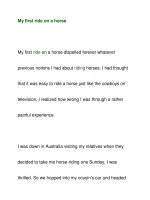my first britannica 1
Bạn đang xem bản rút gọn của tài liệu. Xem và tải ngay bản đầy đủ của tài liệu tại đây (4.56 MB, 97 trang )
CHICAGO LONDON NEW DELHI PARIS SEOUL SYDNEY TAIPEI TOKYO
MY FIRST BRITANNICA
The Earth
and Earth Sciences
1
© 2008 by Encyclopædia Britannica, Inc.
International Standard Book Number:978-1-59339-476-9 (set)
No part of this work may be reproduced or utilized in any form or by any means, electronic or mechanical,
including photocopying, recording, or by any information storage and retrieval system, without permission
in writing from the publisher.
My First Britannica:
Volume 1: The Earth and Earth Sciences 2008
Britannica.com may be accessed on the Internet at .
Encyclopædia Britannica, Britannica, and the Thistle logo are registered trademarks of Encyclopædia Britannica, Inc.
How to go to your page
This eBook contains four volumes. Each volume has its own page
numbering scheme, consisting of a volume number and a page number,
separated by a colon.
For example, to go to page 5 of Volume 1, type V1:5 in the "page #" box
at the top of the screen and click "Go." To go to page 5 of Volume 2,
type V2:5… and so forth.
The Earth and Earth Sciences
TABLE OF CONTENTS
INTRODUCTION. . . . . . . . . . . . . . . . . . . . . . . . . . . . . . . . 5
Geography: Learning About the Earth . . . . . . . . . . . . . . . . 6
Land and Landforms
Continents: The Largest Pieces of Land . . . . . . . . . . . . . . 8
Antarctica: A Continent of Extremes . . . . . . . . . . . . . . . . 10
Islands: Dry Spots in a Watery World . . . . . . . . . . . . . . . 12
Volcanoes: Mountains of Smoke and Fire. . . . . . . . . . . . . 14
Mountains: Building Earth’s Giant Landscapes . . . . . . . . 16
Sand: The Nitty-Gritty . . . . . . . . . . . . . . . . . . . . . . . . . . . 18
Deserts: Lands of Little Water . . . . . . . . . . . . . . . . . . . . . 20
Peninsulas: Fingers of Land . . . . . . . . . . . . . . . . . . . . . . 22
Rainforests: Endangered Ecosystems . . . . . . . . . . . . . . . 24
Marshes: Grassy Wetlands . . . . . . . . . . . . . . . . . . . . . . . 26
Swamps: Waterlogged Forests. . . . . . . . . . . . . . . . . . . . . 28
Water
Rivers: The Power of Flowing Water . . . . . . . . . . . . . . . . 30
Floods: Engulfed by Water . . . . . . . . . . . . . . . . . . . . . . . . 32
Oasis: Water in the Desert . . . . . . . . . . . . . . . . . . . . . . . . 34
Oceans: The World of Water. . . . . . . . . . . . . . . . . . . . . . . 36
Atlantic Ocean: The Youngest Ocean. . . . . . . . . . . . . . . . . 38
Pacific Ocean: Largest Ocean in the World . . . . . . . . . . . . 40
Indian Ocean: Ocean Between Many Continents . . . . . . . . 42
Mediterranean Sea: The Sea in the Middle of Land . . . . . 44
Tides: The Ocean’s Rise and Fall. . . . . . . . . . . . . . . . . . . 46
Waves: Movement on the Seas . . . . . . . . . . . . . . . . . . . . . 48
Tsunamis: Waves of Destruction . . . . . . . . . . . . . . . . . . . 50
Icebergs: The Biggest Ice Cubes. . . . . . . . . . . . . . . . . . . . 52
Glaciers: Rivers of Ice . . . . . . . . . . . . . . . . . . . . . . . . . . . 54
Climate and Environment
Clouds: Floating Water . . . . . . . . . . . . . . . . . . . . . . . . . . 56
Thunder and Lightning: Nature’s Fireworks . . . . . . . . . . 58
Cyclones and Tornadoes: Nature’s Fury . . . . . . . . . . . . . . 60
Rainbows: Arcs of Color. . . . . . . . . . . . . . . . . . . . . . . . . . 62
Dew: Diamond Drops of Water . . . . . . . . . . . . . . . . . . . . . 64
Leaves: The Science of Their Changing Colors . . . . . . . . . 66
Echoes: Sounds That See in the Dark . . . . . . . . . . . . . . . 68
Acid Rain: Killer Downpour . . . . . . . . . . . . . . . . . . . . . . . 70
Pollution: Harming Our Environment. . . . . . . . . . . . . . . . 72
Geology and Prehistory
Geology: Studying the Earth . . . . . . . . . . . . . . . . . . . . . . 74
Rocks and Minerals: The Earth’s Building Blocks . . . . . . 76
Caves: When Water Is Stronger than Stone . . . . . . . . . . . 78
Diamonds:
The Hardest-Working Gemstones in the World . . . . . . . 80
Chalk: The Remains of Tiny Shells . . . . . . . . . . . . . . . . . 82
Fossils: Ancient Life in Stone . . . . . . . . . . . . . . . . . . . . . 84
Mammoths and Mastodons: Ancient Elephants . . . . . . . . 86
Dinosaurs: Giants of the Past . . . . . . . . . . . . . . . . . . . . . 88
Dinosaurs: A Mystery Disappearance. . . . . . . . . . . . . . . . 90
Tyrannosaur: The Tyrant King . . . . . . . . . . . . . . . . . . . . 92
GLOSSARY. . . . . . . . . . . . . . . . . . . . . . . . . . . . . . . . . . . 94
INDEX . . . . . . . . . . . . . . . . . . . . . . . . . . . . . . . . . . . . . . 95
Lightning storm, Tucson, Arizona
© Tom Ives/Corbis
Cover photos (top): lightning storm, Tucson, Arizona, © Tom Ives/Corbis; (center): maple leaf, © Corbis; (bottom): illustration by Joseph Taylor
The Earth and Earth Sciences
MY FIRS T BRITANNICA
Have a great trip!
In Volume 1,
The Earth
and Earth
Sciences
, you’ll
discover answers to these
questions and many more.
Through pictures, articles,
and fun facts, you’ll learn
about weather, study
oceans and landscapes,
and go back in time to the
days of the dinosaurs.
INTRODUCTION
What’s another name for giant floating ice cubes?
How did the dinosaurs disappear?
Is a “finger of land” smaller than your hand? What’s an oasis?
To help you on your journey, we’ve provided the following guideposts in
The Earth and Earth Sciences
:
■ Subject Tabs—The colored box in the upper corner of each right-hand
page will quickly tell you the article subject.
■ Search Lights—Try these mini-quizzes before and after you read the
article and see how much—and how quickly—you can learn. You can even
make this a game with a reading partner. (Answers are upside down at the
bottom of one of the pages.)
■ Did You Know?—Check out these fun facts about the article subject.
With these surprising “factoids,” you can entertain your friends, impress
your teachers, and amaze your parents.
■ Picture Captions—Read the captions that go with the photos. They
provide useful information about the article subject.
■ Vocabulary—New or difficult words are in bold type. You’ll find
them explained in the Glossary at the back of this volume. And there’s a
complete listing of all Glossary terms in the set in the Reference Guide
and Index, Volume 13.
■ Learn More!—Follow these pointers to related articles throughout the set.
And don’t forget: If you’re not sure where to start, where you saw something
before, or where to go next, the Index at the back of this volume and the
Reference Guide and Index (Volume 13) will point the way.
Geography is a science that studies the Earth’s surface. It studies what
makes the different shapes and colors of the Earth—the ground, rocks, and
water, what does and does not grow.
If you look at the Earth as a geographer does, then you might see it as
a colorful map. Much more than half of it is blue with oceans, lakes, rivers,
and streams. In some places it is tan-colored with the sands of dry deserts.
In other places it is green with forests. There are purple-gray mountains
and white snowcapped peaks. And there are the soft yellow of grainfields
and the light green of leafy crops.
Part of learning about the Earth is learning where people can and can’t
live. The different colors of your Earth map can help you discover this.
You won’t find many people in the tan, white, or larger blue parts—
deserts, the snowfields, and oceans. Not many people live in the deserts,
because deserts are hot and dry. Very few plants can grow there. In the high
mountains and at the North and South poles, it is very cold. Most plants
don’t like the cold, and most people don’t either.
You will find people in and near the green and yellow parts and the
smaller blue parts—the farmlands, forests, rivers and lakes. To those
regions you can add brown dots and clusters of dots, for towns and cities.
There’s a lot to learn about the Earth, just as there’s a lot to learn about
a friend. Geography helps you become a friend of the Earth.
L
EARN MORE! READ THESE ARTICLES…
CONTINENTS (VOLUME 1) • FERDINAND MAGELLAN (VOLUME 4)
OCEANS (VOLUME 1)
t
h
e
E
a
r
t
h
L
e
a
r
n
i
n
g
A
b
o
u
t
The coast of Nova Scotia, in Canada, shows some of the
Earth’s many shapes and colors. Geography looks closely
at what makes these different shapes and colors.
© Raymond Gehman/Corbis
DID YOU KNOW?
The “big blue marble” is a nickname
for the planet Earth. This is because
from space our world looks like a big
round marble, all blue with swirling
white streaks of clouds.
6
TITLE HERE
7
GEOGRAPHY
Areas where
not many people
live are also the
areas where few
plants grow. Why do
you think that is?
(Hint: What do you do
with lettuce, beans,
and apples?)
S
E
A
R
C
H
L
I
G
H
T
Answer: If few plants grow in an area, then few animals will live
there. This is because animals need either plants or other animals
to eat. And without plants or animals, there’s nothing for people
to eat.
★
8
The continents are the largest bodies of land on the Earth. Look at a
globe. Whatever is blue is water. Most of the rest is land: the continents.
There are seven continents. From biggest to smallest, they are Asia,
Africa, North America, South America, Antarctica, Europe, and Australia.
Some continents, such as Australia and Antarctica, are completely
surrounded by water. And some continents are joined together, as Asia and
Europe are.
Continents are physical bodies, defined by their shape, size, and
location. They have mountains, rivers, deserts, forests, and other physical
features. But humans have divided them into political groups, called
“countries” or “nations.”
Large continents, such as Asia, may include both very large countries,
such as China, and very small countries, such as Nepal. Australia, the
smallest continent, is also itself a country—one of the world’s largest.
North America contains three large countries—Canada, the United
States, and Mexico—and a few small countries in a region known as
Central America. Europe, on the other hand, is the world’s second smallest
continent but has about 50 countries.
Africa, the second largest continent, is believed to be where the very
first humans appeared. The continent of Antarctica is all by itself down at
the South Pole. It is rocky and is covered by thick ice that never melts.
Only a few plants and animals can be found along its seacoasts.
Earth scientists believe that the continents began forming billions
of years ago. Lighter parts of Earth’s molten core separated from
heavier parts and rose to the top. As they cooled off and became
solid, the land that would become the continents formed.
The continents were probably joined together at first and
then drifted apart. One theory supposes that there were once two
“supercontinents”: Gondwanaland in the south and Laurasia in
the north.
T
h
e
L
a
r
g
e
s
t
P
i
e
c
e
s
o
f
L
a
n
d
Name
the seven
continents.
S
E
A
R
C
H
L
I
G
H
T
LEARN MORE! READ THESE ARTICLES…
AFRICA (VOLUME 8) • AUSTRALIA (VOLUME 7) • EUROPE (VOLUME 6)
SOUTH AMERICA
NORTH AMERICA
TITLE HERE
9
CONTINENTS
DID YOU KNOW?
Here’s a silly rhyme to help you remember
the continents:
Africa is hot,
Antarctica is cold.
Asia is crowded,
Europe is old.
There’s an America down South,
and one up North too,
And Australia has the kangaroo.
AUSTRALIA
ANTARCTICA
ASIA
EUROPE
AFRICA
Answer: Africa, Antarctica, Asia, Australia, North America, South
America, and Europe.
★
10
Antarctica is the coldest, windiest, and highest continent in the world!
It lies at the bottom of the world, surrounding the South Pole. The name
Antarctica means “opposite to the Arctic,” referring to the Arctic Circle on
the other side of the world.
The coldest temperature recorded in Antarctica is also the world’s
lowest, at –128.6° F. A sheet of ice covers the entire continent. At its
thickest point, the ice is almost 3 miles deep—and that’s on top of the
ground. The continent contains most of the world’s ice and much of the
world’s freshwater. Toward the edges of the continent, the ice becomes
glaciers, creeping rivers of ice.
Strange and wonderful Antarctica has only one day in the entire year.
The Sun generally rises on September 21 and sets on March 22. This one
long day is the summer! From March 22 until September 21, the South
Pole is dark and Antarctica has its night, or winter.
People do not live permanently in Antarctica. Only scientists and some
adventurous tourists visit. There are, however, 45 species of birds in
A
C
o
n
t
i
n
e
n
t
o
f
E
x
t
r
e
m
e
s
DID YOU KNOW?
Antarctica is a desert—a “frigid
desert.” It’s extremely cold, unlike
the more common hot sandy deserts.
But like them, it gets so little
moisture during the year that very
little life can survive.
TITLE HERE
11
ANTARCTICA
Antarctica, including the emperor penguin and the Adélie
penguin, that live near the seacoast. Also, four species of seals
breed only in Antarctica.
Whales live in the water around the frigid continent. The
killer whale, the sperm whale, the rare bottle-nosed whale, the
pygmy whale, and seven species of baleen whales can all be
found off the coast.
Oddly, there are active volcanoes in Antarctica. That
means you can find not just the world’s coldest temperatures
here but, deep down, some of the hottest too.
L
EARN MORE! READ THESE ARTICLES…
GLACIERS (VOLUME 1) • PENGUINS (VOLUME 11)
WHALES (VOLUME 12)
Answer: 45 —
bird species
3 (miles) —
thickness of ice
182.5 (days) —
length of one day
–128.6 (° F) —
coldest temperature
These emperor penguins are some of Antarctica’s very few
inhabitants. So in a way they might indeed be considered the
“rulers” of this harsh and beautiful frozen desert continent.
© Galen Rowell/Corbis
Match the
numbers with the
correct labels.
You may have to
do some figuring and
clever thinking!
–128.6
bird species
182.5
thickness of ice
3
length of one day
45
coldest temperature
S
E
A
R
C
H
L
I
G
H
T
★
12
Islands are areas of land surrounded on all sides by water.
Islands come in all shapes and sizes. The very smallest are too
small to hold even a house. The largest islands contain whole
countries.
If you live in England, Iceland, Australia, or Japan, you live
on an island. But these islands are so large that you might walk
all day and never see water.
How do islands develop in the first place?
Some islands begin as fiery volcanoes in the ocean. Hot
lava pours out of the volcano,
making the island bigger and
bigger. Slowly, as the lava cools,
it becomes solid land, and when it rises above
the water, it becomes an island. These are the
volcanic islands.
Other islands are actually parts of the world’s
continents. Some of the land toward the edge of
the continent may have been worn away over
many, many years by wind or rain, or perhaps
some of it sank. Then water from the ocean
filled the low places and made a new island.
A row of islands may once have been the
tops of mountains in a mountain range. The Aleutian Islands off the coast
of North America were probably once a part of a mountain range that
connected Alaska with Asia.
Maybe most surprising are the islands that are built up from the bottom
of the ocean from the skeletons of tiny sea animals called “coral.” As some
corals die, others live on top of them. After thousands of years a coral island
rises to the ocean surface. And these islands go on living!
L
EARN MORE! READ THESE ARTICLES…
CORAL (VOLUME 11) • SEYCHELLES (VOLUME 8) • VOLCANOES (VOLUME 1)
D
r
y
S
p
o
t
s
i
n
a
W
a
t
e
r
y
W
o
r
l
d
Small island in the South Pacific Ocean.
© Craig Tuttle/Corbis
This photo from the air shows one of the
islands of the Maldives, a country made up
of about 1,200 islands in the Indian Ocean.
© Lawson Wood/Corbis
Find and
correct the
error in the
following
sentence: Coral
islands are made of
tiny ocean rocks that
have piled on top of
each other for
thousands of years.
S
E
A
R
C
H
L
I
G
H
T
ISLANDS
Answer: Coral islands are made of tiny ocean creatures [or
creatures’ skeletons
] that have piled on top of each other for
thousands of years.
★
DID YOU KNOW?
If you try to count the number of
islands in the world by looking at a
globe, you’ll probably come up with
300 or so. But that’s only the major
islands. Altogether the total is closer
to 130,000.
DID YOU KNOW?
The remains of ancient Pompeii and the
other cities buried by Mount Vesuvius’
eruption were amazingly preserved.
Loaves of bread that had been baking
at the moment were found. These
discoveries marked the beginning of
the modern science of archaeology.
VOLCANOES
15
Deep under the Earth’s surface it’s so hot that even rock
melts. Sometimes this molten rock, called “magma,” is
pushed up to the Earth’s surface. At that point it is referred
to as “lava.” And the opening, or vent, that lets the lava out
is a volcano.
A volcano may explode violently, throwing rocks for
miles. Or it might push the lava out so that it flows away, cools,
and hardens. Some volcanoes release clouds of poisonous gas
or huge clouds of ash. Volcanoes can even do all these things
underwater.
Most volcanoes have been around for a very long time.
Many haven’t erupted in years and have cooled off.
Volcanoes that won’t be erupting anymore are called
“dead volcanoes.”
Some volcanoes still let off smoke. These “sleeping volcanoes” may
“wake up” someday and start erupting. Mount Vesuvius in Italy slept for
a thousand years. But one day in
AD 79 it suddenly woke up. Its eruption
spewed hot ash and rocky fragments that buried the city of Pompeii. A hot
mud flow buried nearby Herculaneum. The remains are so well preserved
that the area has been named a World Heritage site.
But not all volcanoes are destructive. If a volcano spits out enough lava
and debris, it piles up into a mountain. The Hawaiian Islands and the
island of Iceland were created this way.
Other volcanoes help provide heat and energy. Many Icelandic homes
get their hot water from springs heated by volcanic steam. That steam can
also be used to produce electricity. Also, plants grow very well in the rich
soil left by volcanoes. And valuable gems, such as diamonds, can
sometimes be found in the rocks that volcanoes spit out.
L
EARN MORE! READ THESE ARTICLES…
MOUNTAINS (VOLUME 1) • NICARAGUA (VOLUME 9) • REYKJAVIK (VOLUME 6)
Answer: b) oil
★
© Douglas Peebles/Corbis
M
o
u
n
t
a
i
n
s
o
f
S
m
o
k
e
a
n
d
F
i
r
e
Which of
the following
is
not
often
spit out by
volcanoes?
S
E
A
R
C
H
L
I
G
H
T
a) lava
b) oil
c) gas
d) ash
e) steam
16
What makes mountains? Several different processes
contribute to mountain building. And most mountains are formed
by a combination of these, usually over millions of years.
Deep inside, the Earth is so incredibly hot that everything
is melted, or molten. This molten material, or lava, escapes to
the Earth’s surface when volcanoes erupt. The lava cools and
becomes hard and solid. This happens again and again,
collecting until there is a volcanic mountain.
Mount Fuji in Japan and Mount St. Helens in
Washington state, U.S., are volcanic mountains. There are also many
undersea volcanic mountains—much taller than anything on land!
In some cases strong earthquakes caused the surface rock for miles and
miles to break. Part of the surface would then be lower and part of it
higher. More earthquakes moved the lower parts down and the upper parts
up. Eventually, the high parts became tall enough to make mountains.
Still other mountains were pushed up from the bottom of an ocean
when two enormous portions of the Earth crashed together—very slowly,
over millions and millions of years. Some of the largest mountain chains
formed this way. The Andes of South America are an example.
Another mountain-building process is called “folding.” If you push a
carpet up against a wall, it folds and rumples. That’s basically the way the
Appalachian Mountains in eastern North America were formed.
At first most mountains were steep and sharp. But even hard rocks can
be worn away. Slowly, with the wind and the rain rubbing at them, steep
sharp mountains grow smoother, shorter, and rounder.
B
u
i
l
d
i
n
g
E
a
r
t
h
’
s
G
i
a
n
t
L
a
n
d
s
c
a
p
e
s
Mountains
are made when
a) volcanoes erupt.
b) earthquakes happen.
c) the Earth pushes
together.
d) all of the above.
S
E
A
R
C
H
L
I
G
H
T
© David Muench/Corbis
DID YOU KNOW?
To be considered a mountain, the land
must rise at least 2,000 feet above its
surroundings. Mount Everest, the world’s
highest mountain, rises 29,035 feet
above sea level.
LEARN MORE! READ THESE ARTICLES…
ANDES (VOLUME 9) • TENZING NORGAY (VOLUME 4)
VOLCANOES (VOLUME 1)
TITLE HEREMOUNTAINS
Answer: d) all of the above.
★
18
You can find sand at the edge of lakes, the bottoms of rivers, and the
seashore. You can find it in mountain valleys, deserts, and, of course, a
sandbox. Where does all this sand come from?
Sand is created when rocks break into tiny, tiny pieces. Wind, ice, and
rain knock against high mountain cliffs. And slowly, over millions of years,
these forces break off pieces of rock. The pieces bounce down the
mountainside and break off other pieces of rock—while it’s also breaking
into smaller and smaller pieces itself. It isn’t sand yet, but it’s getting there.
Rivers and glaciers are also good at making sand. A river’s water
rushes along, carrying rocks with it and breaking them into little pieces.
The ice of a glacier grinds away at whatever rocks it slowly rolls across.
Another great sand maker is the ocean. Every day, all over the world,
tides rise and fall, pushing against rocks over and over. Waves tear at the
rocks along the shore, wearing them down.
Thanks to the weather, water, and ice, some of these broken rocks
finally get so small that they become what we call “sand.”
Now that you have all this sand, what can you do with it? Sand is used
for paving roads. Bricks made with sand are harder and stronger than other
bricks. Sand is also used to filter (or clean) water. When it’s sprayed with
great force against stone or brick, it can grind away thick layers of dirt or
even paint in a process called “sandblasting.”
And, of course, sand is great for building sand castles!
T
h
e
N
i
t
t
y
-
G
r
i
t
t
y
Mounds or ridges of sand like these are called
“sand dunes.” They’re caused by the combined
action of wind and gravity.
© Dave G. Houser/Corbis
True or
false?
Sand can be
used to clean
buildings.
S
E
A
R
C
H
L
I
G
H
T
LEARN MORE! READ THESE ARTICLES…
ALGERIA (VOLUME 8) • DESERTS (VOLUME 1) • OCEANS (VOLUME 1)
SAND
19
Answer: TRUE. Sandblasting is a powerful process for cleaning
stone or brick.
★
DID YOU KNOW?
Once a year the Harrison Hot Springs
resort in British Columbia, Canada,
holds the world championship of sand
sculpting. The rules say sculptures
can be made only of water and sand,
and they must be finished in under
100 work hours.
20
Deserts are places that get very little rain each year—so little rain that
most trees and plants cannot grow there. Some deserts will go for years
without rain. They are difficult places to live in, and the few plants,
animals, and people who live there have
to be tough to survive. Every continent
except Europe has a desert. Even
Antarctica has one, a frigid desert.
Most deserts, however, are arid, or
dry, deserts with mile after mile of sand,
baked earth, and barren rock. In the
daytime these places look like lost
worlds—hot, dry, and silent. Usually, the
only plants growing there are low thorny
ones. These plants store most of the water they are able to collect. It may
be a long time before their next drink.
At night it can be quite cold in the desert. That’s when creatures that
have been hiding from the Sun’s burning rays come out of their homes.
Many of the creatures are lizards and insects such as scorpions. There are
also different kinds of rats as well as other, larger animals.
You can hear the animals squeaking and growling near water
holes and springs. That’s where the coyotes, badgers, bobcats,
foxes, and birds gather, all hunting for food and water. When the
rare spring does bubble up in the desert, plants and trees begin to
grow. An island of green like this is called an “oasis.”
Many people choose to live in the desert. In late afternoon the sky
turns crimson and gold, and the mountains make purple shadows.
And at night the stars seem close enough to touch.
L
EARN MORE! READ THESE ARTICLES…
ALGERIA (VOLUME 8) • CAMELS (VOLUME 12) • OASIS (VOLUME 1)
L
a
n
d
s
o
f
L
i
t
t
l
e
W
a
t
e
r
This California (U.S.) desert, called Death Valley, is
both beautiful and dangerous. It’s also the lowest point
below sea level in the Western Hemisphere.
Joseph Sohm—Chromosohm/Photo Researchers
Golden desert snapdragons, or yellow Mojave
flowers, in Death Valley, California, U.S.
© Darrell Gulin/Corbis
Fill in
the blank:
Every continent
except
____________
has a desert.
S
E
A
R
C
H
L
I
G
H
T
21
DESERTS
Answer: Every continent except Europe has a desert.
DID YOU KNOW?
Desert sands are known to
“sing.” For some reason that
scientists do not yet fully
understand, sand sometimes
makes a booming, barking, or
humming noise when walked
upon or moved by some other
natural force.
★
Apeninsula is a body of land surrounded by water on three sides. The word
“peninsula” comes from the Latin paene insula, meaning “almost an island.” There
are peninsulas on every continent, but every one is different. Most peninsulas of any
significance extend into oceans or very large lakes.
In the United States, Florida is a peninsula. The state of Alaska qualifies as one
and has several smaller peninsulas of its own.
One of the last great wilderness areas in the United States is on the Olympic
Peninsula in Washington state. It is surrounded by the Pacific Ocean, the Strait of
Juan de Fuca, and Puget Sound. It has a rainforest, rivers, alpine peaks, glaciers, and
such creatures as salmon and elk.
In Mexico there are two main peninsulas, the Yucatán Peninsula in the east and
Baja California in the west. The Yucatán Peninsula draws tourists to the ruins of
great Mayan cities such as Uxmal and Chichén Itzá.
Another famous peninsula is the Sinai Peninsula of Egypt. It is triangular in
shape. The peninsula links Africa and Asia. In Jewish history the Sinai Peninsula is
known as the site where God appeared before Moses and gave him the Ten
Commandments.
Europe too has several peninsulas. In northern Europe the Scandinavian
Peninsula contains the countries of Norway and Sweden. Denmark forms another.
And the Iberian Peninsula in southern Europe is made up of Spain and Portugal. Italy
and part of Greece are peninsulas as well.
The world’s largest peninsula is Arabia, at over a million square miles. Other
important peninsulas in Asia include Korea and Southeast Asia.
L
EARN MORE! READ THESE ARTICLES…
ISLANDS (VOLUME 1) • ITALY (VOLUME 6) • KOREAN PENINSULA (VOLUME 7)
F
i
n
g
e
r
s
o
f
L
a
n
d
This peninsula in the U.S. state of Michigan is small
by some standards. But it’s an excellent example of
what a peninsula looks like.
© James L. Amos/Corbis
22
23
PENINSULAS
Answer: The only two that are
not
peninsulas are Hawaii and
Britain. They are islands.
★
DID YOU KNOW?
Peninsulas such as Iberia (Spain and
Portugal), Italy, and Florida tend to
be popular tourist destinations. For
example, Florida gets almost 59
million tourists a year.
Which of the
following are
peninsulas?
(Feel free to
consult your
classroom map
or globe.)
S
E
A
R
C
H
L
I
G
H
T
Korea
Portugal
Italy
Hawaii
Britain
Arabia
Denmark
Florida
24
Imagine a forest with a carpet of wet leaves littering the ground. If
you look up, you see only a canopy of broad green leaves. There are
wildflowers on the trees. You can hear water drops, insects, birds, and,
perhaps, the distant screech of a monkey. The place you are picturing
is a rainforest.
A rainforest is a kind of ecosystem—a community of all the living
things in a region, their physical environment, and all their
interrelationships.
Rainforests are dense, wet, and green because they get large amounts
of rain. The Amazon Rainforest in South America is the world’s largest
rainforest. Other large rainforests lie in Central
Africa and Southeast Asia. Northeastern
Australia’s “dry rainforest” has a long dry
season followed by a season of heavy rainfall.
In a rainforest nothing is wasted. Everything
is recycled. When leaves fall, flowers wilt, or
animals die on the forest floor, they decay. This
releases nutrients into the soil that become food
for the roots of trees and plants. Water
evaporates in the forest and forms clouds above
the trees. Later this water falls again as rain.
Rainforests are rich in plants and animals.
Many have not even been discovered yet. Some
rainforest plants have given us important
medicines. These include aspirin, which is a pain reliever, and curare, used
to help people relax during medical operations.
Unfortunately, the rainforests are being destroyed rapidly. The trees
are felled for timber and to create land for farming. Animals living in
these forests are facing extinction. And once lost, these animals and forests
cannot be replaced.
L
EARN MORE! READ THESE ARTICLES…
AMAZON:RAINFOREST RIVER (VOLUME 9) • CONGO (VOLUME 8)
MEDICINE (VOLUME 2)
E
n
d
a
n
g
e
r
e
d
E
c
o
s
y
s
t
e
m
s
View of the Venezuelan rainforest
canopy from the air.
© Fotografia, Inc./Corbis









